Lumpia: A complete package, gifted to Apples & Thyme
Gift Wrapping
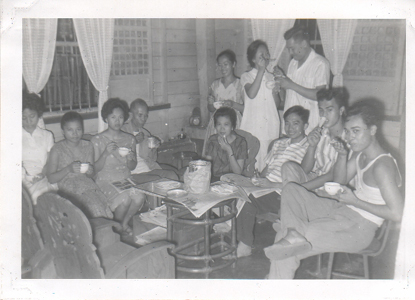
Mom and Dad toward the back right, feeding each other in the Philippines, in the 1950s.
It was just the natural order of things: Mom cooked, and then fed us what she’d cooked.
The first thing that Mom taught me to cook was rice. The second thing was lumpia (LOOM-pee-yah). And she makes the best lumpia of all the moms!
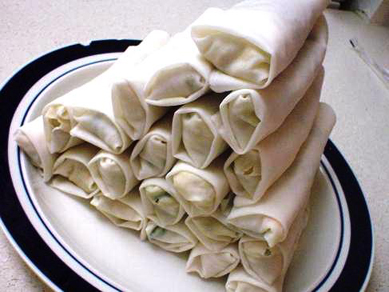
Lumpia, circa 2006.
Even during the worst of our fights, we could still wrap the lumpia at the same table and remain civil. We’d even compliment each other.
“This smells good, Mom,” I’d offer, relishing the full aroma of whatever she’d managed to find—ground meat—pork, usually—cabbage, tofu, carrot, mung bean noodles, celery, all seasoned with garlic, onion, salt, pepper, and of course MSG.
A moment later, watching the layers of lumpia fill the pan, Mom would say, “Hey, you’re fast!”
Then we’d both feel proud the way a mother and daughter always wanted to feel proud.
The whole process was about sharing. Mom would cook the lumpia filling, then call me into the kitchen. I’d put two plates on the table, one for each of us. She’d put the cooled, drained filling on the table between us, scramble an egg into a bowl while I got the pastry brush out from the drawer, then one of us would open the package of thin, delicate lumpia wrappers. She’d peel the top one off for me, checking to see if the on-sale brand would tear. We’d go from there.
Line some filling into the middle of the wrapper, fold one edge over the top, and then gather the filling tightly into the wrapper—not too tightly, or the filling might burst out in the hot oil, and not too loosely, or the lumpia might unroll. Tuck, roll, stop halfway, fold one end in, then the other, tuck, roll, paint some beaten egg onto one end, and finish. Nestle it into the cake pan, the first, into the corner, lonely for only a moment. Then Mom’s first lumpia would join mine. We’d take turns. When I’d start to get ahead, she’d pull a handful of wrappers apart from the stack so we could just grab and use them without pausing our rhythm for too long. We’d take turns dipping our filling out of the colander, take turns with the pastry brush, taking turns settling them in. When we were fighting about something, wrapping lumpia would act as a pacifier for us. Trading our way around the table, it was a silent yet fair conversation, even and uniform, a gift exchange.
As we got close to finishing, Mom would start heating oil in the old iron skillet. Once we’d used all the lumpia filling, one of us would wash out the colander, line it with several paper towels, and set it on a plate to catch the dripping grease so we could throw it out. She’d hover her hand briefly over the oil, letting her internal thermometer tell her if it was ready, and as a double-check, she’d tentatively dip in one end of a fresh lumpia. If it immediately sent up a cry of bubbles, we knew it was hot enough. She’s float several into the oil for a couple of minutes, turn them to cook the other side, then set them, standing on their ends, into the colander, the hot grease sliding from their newly browned skins. The house would soon fill with the smell of the hot, crisp wrappers, our petty disagreements wafting away, dissipating completely when she’d put the last lumpia into the colander to dry, happily yelling out to the house to call us to our plates, “Let’s eat!”
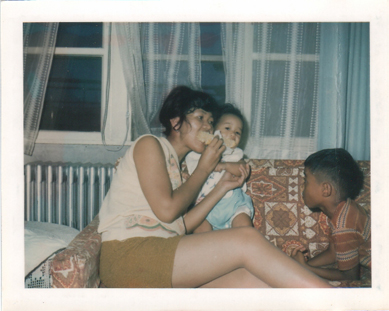
Mom and Norm while Alvin looks on hungrily, back in the 60s.
Lumpia is the ultimate gift, from mother to her family, and then out into the extended family and close friends, piled high on giant platters during family gatherings. In this post, I am celebrating my mom for the Apples & Thyme event, celebrating our mother figures and how they stand in our kitchens today.
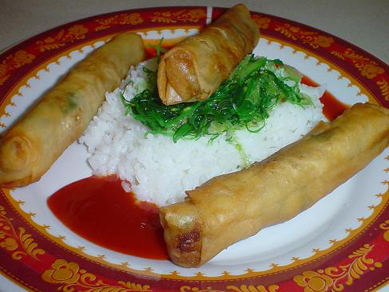
My ridiculous plating for a past lumpia dinner, 2006, with rice, seaweed salad, and some simple duck sauce. Really, just line a few up on your plate, side by side, and run with it.
Filipino Food Night, November 4, 2007
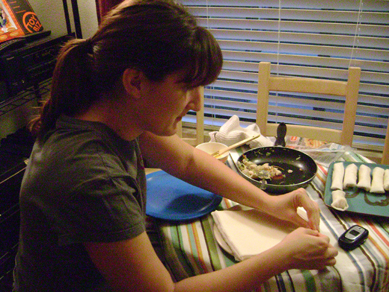
I had several dishes going, and I intentionally invited friends over to learn how to wrap lumpia. Wendy arrived early to hang out, so I taught her first.
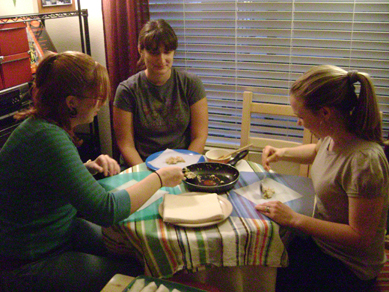
Then Wendy taught Jen B. and Elizabeth.
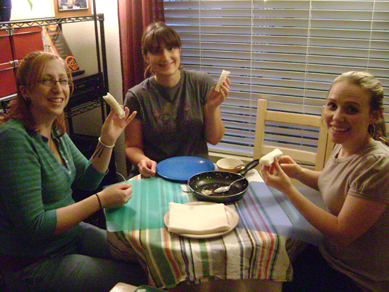
Raise ‘em up, girls! The Lumpiettes! Honorary Filipinos.

Piled high. Good job! I’m so proud!
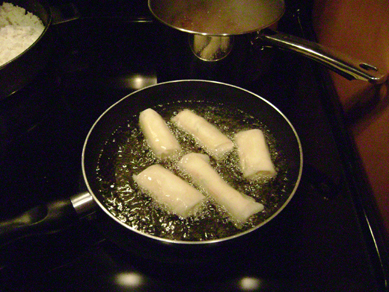
Jen B. took over the task of frying the lumpia so I could turn my attention to finishing other dishes (adobo sauce reducing in the back, rice for the fried rice to the back left, and not shown, sinigang na bangus--milkfish tamarind soup--to the left)and taking care of guests.
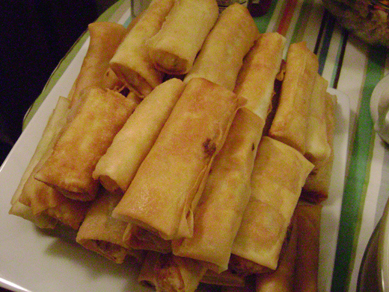
Fried lumpia! Let’s eat!
Lumpia Recipe
In the style of my mom, I can’t really give you an exact recipe for lumpia. Use what’s around or what you buy specifically for the filling.
The primary ingredient is the wrapper—the messenger. Without a diplomatic wrapper, you may end up wanting to shoot the messenger. Even wrappers advertised as Filipino wrappers can fry up with that thick, bubbly, doughy shell that marks the standard Westernized Chinese egg roll. After growing up on lumpia’s thin-skinned, high-crisp dynamic, I don’t enjoy those egg rolls. I’m also always disappointed when I do brave an egg roll to find it stuffed only with cabbage. While I’ve made plenty of vegetarian-friendly lumpia, they’ve never been as monochrome as the cabbage-only egg roll. I often cheat on my cabbage and just use instant bag o’ slaw since it removes the work of julienning cabbage and carrots.
The seasonings are constant—garlic, onion, splash of soy sauce, grind of garlic. I’ve used garlic and onion powders in place of the real thing, and they’ve worked fine, too. Whatever version of garlic and onion I’ve used, I’ve always sauted them first in hot oil (olive, vegetable, whatever’s on hand), then added the meat.
I was raised on ground pork, and later ground turkey when Mom got into that semi-healthy kick (I mean turkey’s fine, but you’re putting it into a deep-fried cylinder … ). She’d also add tofu, and sometimes, I use only tofu as the protein, adding it after the veggies instead of before so that it maintains some integrity of its true form. At Filipino food night, I had reserved the chicken tenders from the chicken I fabricated for the chicken adobo, and I diced the tenders up for the non-veg lumpia, while the rest used tofu.
As I saw my friends near the bottom of the pot of filling, I started to heat up about a half inch of veg oil (peanut, canola, whatever’s around) in my skillet, and by the time they were done, I was able to hover my hand over the hot oil, feel that it was hot, and double-check by dipping in one end of a lumpia to hear it sing. Settle them in slowly, one at a time, so you don’t drop your oil temp too quickly. They should take only a few minutes to cook on each side. If it takes longer, your oil wasn’t actually hot enough even if your lumpia did bubble at first—it was just enthusiastic.
What? You still need an actual recipe, with numbers and measurements? Heh, tell that to my mom. I’ll oblige, though.
Soak to soften:
2 cups dry glass noodles (mung bean noodles), about 30 minutes
Heat:
1 Tbsp oil
Slowly saute and brown:
2 minced fat garlic gloves
1 diced onion (this isnt’ a typo—if you can’t sauté your garlic before your onion without burning your garlic, then just add the onion first, then the garlic, but if your heat is just below med and you keep your spoon moving your garlic, you shouldn’t have any problem)
Season with:
½ teaspoon salt
3-5 grinds of black pepper
Add and brown:
1 pound of meat—ground or diced pork, chicken, turkey, beef, etc.
Season with:
1 ½ Tbsp soy sauce
Stir in and thoroughly cook:
4 cups julienned cabbage
½ cup julienned carrots
Season with:
¼ tsp salt
Drain and cut:
Glass noodles into 1” lengths (I just go Freddy Kreuger with my kitchen shears)
Stir in and cook to soften:
All the glass noodles—should be almost 3 loose cups after soaking
Taste for seasoning, then let the filling cool. If it’s watery from all the veggies, place it in a sieve to drain as it cools. One it cools, scramble one egg into a dish and get a pastry brush ready. Open up your wrappers, and carefully unpeel a few. If you’re kinda slow at first, you may want to keep your wrappers on a plate, covered with its own package or a very slightly damp towel so they don’t dry out. Wrap your lumpia like burritos. If you have more than one filling, you can wrap them a little differently so that everyone knows what’s what; I had my friends wrap the chicken lumpia diagonally so the showing end would be a point, and the tofu lumpia squarely so the showing end would be a straight edge. Seal your lumpia with some egg, and place them seam-side down on a platter.
As you get close to finishing the wrapping step, heat up a half inch of oil in a skillet, and get a paper towel-lined colander ready, setting it on a plate or bowl to catch whatever grease escapes through the paper towel. Once the oil looks a little shimmery, around the time some very fine whisps of smoke start to waft up, and once your hand feels afraid when held a few inches over the oil, then you can dip a lumpia end to see how quickly it fries up. Know matter how scary it might get, don’t just fling it into the oil—just lay it in there, away from you so any accidental panic-induced splash goes away from you. Cook until it’s golden brown, then flip the lumpia over. It shouldn’t be very brown, since it will continue to cook a bit after you remove it from the oil. Set the fried lumpia into the paper towel-lined colander, let them cool a little (avoid lawsuit, in other words), then serve with rice and banana ketchup, Heinz 57, or whatever sauce you can concoct. *sigh* No, I don’t have a banana ketchup recipe. Here’s a duck sauce to pacify you: Heat ½ cup apricot jam on low-medium so that it gets saucy, stir in about 3 Tbsp soy sauce, 1/4 tsp minced ginger (or a few dashes of powdered ginger), and ½ tsp chili flakes for heat. Taste, and adjust to suit yourself.

Mom and Dad toward the back right, feeding each other in the Philippines, in the 1950s.
It was just the natural order of things: Mom cooked, and then fed us what she’d cooked.
The first thing that Mom taught me to cook was rice. The second thing was lumpia (LOOM-pee-yah). And she makes the best lumpia of all the moms!

Lumpia, circa 2006.
Even during the worst of our fights, we could still wrap the lumpia at the same table and remain civil. We’d even compliment each other.
“This smells good, Mom,” I’d offer, relishing the full aroma of whatever she’d managed to find—ground meat—pork, usually—cabbage, tofu, carrot, mung bean noodles, celery, all seasoned with garlic, onion, salt, pepper, and of course MSG.
A moment later, watching the layers of lumpia fill the pan, Mom would say, “Hey, you’re fast!”
Then we’d both feel proud the way a mother and daughter always wanted to feel proud.
The whole process was about sharing. Mom would cook the lumpia filling, then call me into the kitchen. I’d put two plates on the table, one for each of us. She’d put the cooled, drained filling on the table between us, scramble an egg into a bowl while I got the pastry brush out from the drawer, then one of us would open the package of thin, delicate lumpia wrappers. She’d peel the top one off for me, checking to see if the on-sale brand would tear. We’d go from there.
Line some filling into the middle of the wrapper, fold one edge over the top, and then gather the filling tightly into the wrapper—not too tightly, or the filling might burst out in the hot oil, and not too loosely, or the lumpia might unroll. Tuck, roll, stop halfway, fold one end in, then the other, tuck, roll, paint some beaten egg onto one end, and finish. Nestle it into the cake pan, the first, into the corner, lonely for only a moment. Then Mom’s first lumpia would join mine. We’d take turns. When I’d start to get ahead, she’d pull a handful of wrappers apart from the stack so we could just grab and use them without pausing our rhythm for too long. We’d take turns dipping our filling out of the colander, take turns with the pastry brush, taking turns settling them in. When we were fighting about something, wrapping lumpia would act as a pacifier for us. Trading our way around the table, it was a silent yet fair conversation, even and uniform, a gift exchange.
As we got close to finishing, Mom would start heating oil in the old iron skillet. Once we’d used all the lumpia filling, one of us would wash out the colander, line it with several paper towels, and set it on a plate to catch the dripping grease so we could throw it out. She’d hover her hand briefly over the oil, letting her internal thermometer tell her if it was ready, and as a double-check, she’d tentatively dip in one end of a fresh lumpia. If it immediately sent up a cry of bubbles, we knew it was hot enough. She’s float several into the oil for a couple of minutes, turn them to cook the other side, then set them, standing on their ends, into the colander, the hot grease sliding from their newly browned skins. The house would soon fill with the smell of the hot, crisp wrappers, our petty disagreements wafting away, dissipating completely when she’d put the last lumpia into the colander to dry, happily yelling out to the house to call us to our plates, “Let’s eat!”

Mom and Norm while Alvin looks on hungrily, back in the 60s.
Lumpia is the ultimate gift, from mother to her family, and then out into the extended family and close friends, piled high on giant platters during family gatherings. In this post, I am celebrating my mom for the Apples & Thyme event, celebrating our mother figures and how they stand in our kitchens today.

My ridiculous plating for a past lumpia dinner, 2006, with rice, seaweed salad, and some simple duck sauce. Really, just line a few up on your plate, side by side, and run with it.
Filipino Food Night, November 4, 2007

I had several dishes going, and I intentionally invited friends over to learn how to wrap lumpia. Wendy arrived early to hang out, so I taught her first.

Then Wendy taught Jen B. and Elizabeth.

Raise ‘em up, girls! The Lumpiettes! Honorary Filipinos.

Piled high. Good job! I’m so proud!

Jen B. took over the task of frying the lumpia so I could turn my attention to finishing other dishes (adobo sauce reducing in the back, rice for the fried rice to the back left, and not shown, sinigang na bangus--milkfish tamarind soup--to the left)and taking care of guests.

Fried lumpia! Let’s eat!
Lumpia Recipe
In the style of my mom, I can’t really give you an exact recipe for lumpia. Use what’s around or what you buy specifically for the filling.
The primary ingredient is the wrapper—the messenger. Without a diplomatic wrapper, you may end up wanting to shoot the messenger. Even wrappers advertised as Filipino wrappers can fry up with that thick, bubbly, doughy shell that marks the standard Westernized Chinese egg roll. After growing up on lumpia’s thin-skinned, high-crisp dynamic, I don’t enjoy those egg rolls. I’m also always disappointed when I do brave an egg roll to find it stuffed only with cabbage. While I’ve made plenty of vegetarian-friendly lumpia, they’ve never been as monochrome as the cabbage-only egg roll. I often cheat on my cabbage and just use instant bag o’ slaw since it removes the work of julienning cabbage and carrots.
The seasonings are constant—garlic, onion, splash of soy sauce, grind of garlic. I’ve used garlic and onion powders in place of the real thing, and they’ve worked fine, too. Whatever version of garlic and onion I’ve used, I’ve always sauted them first in hot oil (olive, vegetable, whatever’s on hand), then added the meat.
I was raised on ground pork, and later ground turkey when Mom got into that semi-healthy kick (I mean turkey’s fine, but you’re putting it into a deep-fried cylinder … ). She’d also add tofu, and sometimes, I use only tofu as the protein, adding it after the veggies instead of before so that it maintains some integrity of its true form. At Filipino food night, I had reserved the chicken tenders from the chicken I fabricated for the chicken adobo, and I diced the tenders up for the non-veg lumpia, while the rest used tofu.
As I saw my friends near the bottom of the pot of filling, I started to heat up about a half inch of veg oil (peanut, canola, whatever’s around) in my skillet, and by the time they were done, I was able to hover my hand over the hot oil, feel that it was hot, and double-check by dipping in one end of a lumpia to hear it sing. Settle them in slowly, one at a time, so you don’t drop your oil temp too quickly. They should take only a few minutes to cook on each side. If it takes longer, your oil wasn’t actually hot enough even if your lumpia did bubble at first—it was just enthusiastic.
What? You still need an actual recipe, with numbers and measurements? Heh, tell that to my mom. I’ll oblige, though.
Soak to soften:
2 cups dry glass noodles (mung bean noodles), about 30 minutes
Heat:
1 Tbsp oil
Slowly saute and brown:
2 minced fat garlic gloves
1 diced onion (this isnt’ a typo—if you can’t sauté your garlic before your onion without burning your garlic, then just add the onion first, then the garlic, but if your heat is just below med and you keep your spoon moving your garlic, you shouldn’t have any problem)
Season with:
½ teaspoon salt
3-5 grinds of black pepper
Add and brown:
1 pound of meat—ground or diced pork, chicken, turkey, beef, etc.
Season with:
1 ½ Tbsp soy sauce
Stir in and thoroughly cook:
4 cups julienned cabbage
½ cup julienned carrots
Season with:
¼ tsp salt
Drain and cut:
Glass noodles into 1” lengths (I just go Freddy Kreuger with my kitchen shears)
Stir in and cook to soften:
All the glass noodles—should be almost 3 loose cups after soaking
Taste for seasoning, then let the filling cool. If it’s watery from all the veggies, place it in a sieve to drain as it cools. One it cools, scramble one egg into a dish and get a pastry brush ready. Open up your wrappers, and carefully unpeel a few. If you’re kinda slow at first, you may want to keep your wrappers on a plate, covered with its own package or a very slightly damp towel so they don’t dry out. Wrap your lumpia like burritos. If you have more than one filling, you can wrap them a little differently so that everyone knows what’s what; I had my friends wrap the chicken lumpia diagonally so the showing end would be a point, and the tofu lumpia squarely so the showing end would be a straight edge. Seal your lumpia with some egg, and place them seam-side down on a platter.
As you get close to finishing the wrapping step, heat up a half inch of oil in a skillet, and get a paper towel-lined colander ready, setting it on a plate or bowl to catch whatever grease escapes through the paper towel. Once the oil looks a little shimmery, around the time some very fine whisps of smoke start to waft up, and once your hand feels afraid when held a few inches over the oil, then you can dip a lumpia end to see how quickly it fries up. Know matter how scary it might get, don’t just fling it into the oil—just lay it in there, away from you so any accidental panic-induced splash goes away from you. Cook until it’s golden brown, then flip the lumpia over. It shouldn’t be very brown, since it will continue to cook a bit after you remove it from the oil. Set the fried lumpia into the paper towel-lined colander, let them cool a little (avoid lawsuit, in other words), then serve with rice and banana ketchup, Heinz 57, or whatever sauce you can concoct. *sigh* No, I don’t have a banana ketchup recipe. Here’s a duck sauce to pacify you: Heat ½ cup apricot jam on low-medium so that it gets saucy, stir in about 3 Tbsp soy sauce, 1/4 tsp minced ginger (or a few dashes of powdered ginger), and ½ tsp chili flakes for heat. Taste, and adjust to suit yourself.
Comments
Jeni
Jeni
Marvin, I only wish I'd paid more attention when I was younger! I pretty much had to learn rice and lumpia, since rice was a daily accompaniment and lumpia was made by the dozens for gatherings and for our own family. For the most part, though, I fled the kitchen and didn't have a happy homecoming back to it until I was in my early 20s!
African Vanielje, thank you! I will look forward to this even every month. One of my favorite aspects of food is how it ties in to our lives socially. I really look forward to reading everyones' stories!
Jeni, thank you! I'm honored to be able to dedicate these words to this event. I won't take the opportunity to share them for granted. Thank you for the inspiration!
I wrote about it on my blog and put a link back to you.
The Duck Sauce was outstanding in my opinion.
Ann, thank you! Please let me know how they work for you. I love sharing those memories--writing them down has been a wonderful exercise for me.
Gay, thank you! I've never seen any two families make the same recipe--it's awesome how many different recipes there are! Have you posted your family's recipe? I'd like to try it!